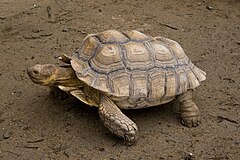Centrochelys
| Centrochelys[1] | |||
| J.E. Gray, 1872[2] | |||
 Przedstawiciel rodzaju – żółw pustynny (C. sulcata) | |||
| Systematyka | |||
| Domena | |||
|---|---|---|---|
| Królestwo | |||
| Typ | |||
| Podtyp | |||
| Gromada | |||
| Rząd | |||
| Podrząd | |||
| Nadrodzina | |||
| Rodzina | |||
| Rodzaj |
Centrochelys | ||
| Typ nomenklatoryczny | |||
|
Testudo sulcata Miller, 1779 | |||
| Gatunki | |||
| |||
Centrochelys – rodzaj żółwi z rodziny żółwi lądowych (Testudinidae).
Zasięg występowania
Rodzaj obejmuje jeden występujący współcześnie gatunek występujący w Afryce (Mauretania, Senegal, Mali, Burkina Faso, Benin, Niger, Nigeria, Kamerun, Czad, Sudan, Erytrea, Etiopia, Sudan Południowy i Republika Środkowoafrykańska)[3][4].
Systematyka
Etymologia
Centrochelys: gr. κεντρον kentron „ostry koniec, kolec”[5]; εμυς emus, εμυδος emudos „żółw wodny”[6].
Podział systematyczny
Do rodzaju należy jeden występujący współcześnie gatunek[3]:
- Centrochelys sulcata (Miller, 1779) – żółw pustynny
oraz wymarłe[7]:
- Centrochelys burchardi (Ahl, 1926)
- Centrochelys marocana Gmira, Lapparent de Broin, Geraads, Lefèvre, Mohib & Raynal, 2013
- Centrochelys robusta (Adams, 1877)
- Centrochelys vulcanica (López-Jurado & Mateo, 1993)
W 1998 roku w oparciu o cztery kości opisano wymarły gatunek Centrochelys atlantica[7], jednak późniejsze badania DNA i datowanie radiowęglowe materiału typowego wykazały, że kości należą do nadal żyjącego gatunku – żabuti czarnego (Chelonoidis carbonarius)[8].
Przypisy
- ↑ Centrochelys, [w:] Integrated Taxonomic Information System (ang.).
- ↑ J.E. Gray: Appendix to the Catalogue of shield reptiles in the collection of the British Museum. Cz. 1: Testudinata (Tortoises). London: The Trustees, 1872, s. 5. (ang.).
- ↑ a b P. Uetz & J. Hallermann: Genus: Centrochelys. The Reptile Database. [dostęp 2024-02-18]. (ang.).
- ↑ R. Midtgaard: Centrochelys. RepFocus. [dostęp 2024-02-18]. (ang.).
- ↑ Jaeger 1944 ↓, s. 47.
- ↑ Jaeger 1944 ↓, s. 81.
- ↑ a b A.G.J. Rhodin, S. Thomson, G.L. Georgalis, H.-V. Karl, I.G. Danilov, A. Takahashi, M.S. de la Fuente, J.R. Bourque, M. Delfino, R. Bour, J.B. Iverson, H.B. Shaffer & P.P. van Dijk. Turtles and Tortoises of the World During the Rise and Global Spread of Humanity: First Checklist and Review of Extinct Pleistocene and Holocene Chelonians. „Chelonian Research Monographs”. 5 (8), s. 1–66, 2015. DOI: 10.3854/crm.5.000e.fossil.checklist.v1.2015. (ang.).
- ↑ Christian Kehlmaier i inni, “Ancient DNA” reveals that the scientific name for an extinct tortoise from Cape Verde refers to an extant South American species, „Scientific Reports”, 11 (1), art. nr 17537, 2021, DOI: 10.1038/s41598-021-97064-2 (ang.).
Bibliografia
- Edmund C. Jaeger, Source-book of biological names and terms, wyd. 1, Springfield: Charles C. Thomas, 1944, s. 1–256, OCLC 637083062 (ang.).
